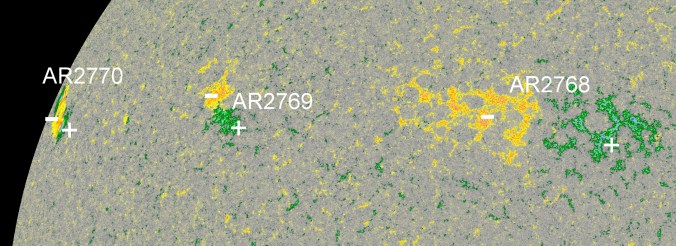August 3, 2020: There’s no longer any doubt. New Solar Cycle 25 is coming to life. The latest sign came today with the emergence of a new sunspot group, AR2770, inset in this magnetic map of the sun’s surface from NASA’s Solar Dynamics Observatory (SDO):

In this false-color image of the sun, intense magnetic fields are denoted by yellow (- polarity) and green (+ polarity).
AR2770 has two dark cores (each about the size of Mars) and is crackling with minor B-class solar flares. Its potential for even stronger flares will become clear in the days ahead as the sunspot turns toward Earth, more fully revealing its magnetic complexity.
Active regions from Solar Cycle 25 are now strewn across the sun’s northern hemisphere. These are places where magnetic fields are intensifying, creating islands of magnetism on the sun’s surface.

The -/+ magnetic polarities of these northern active regions mark them as members of Solar Cycle 25, per Hale’s Law.
In the cases of AR2769 and AR2770, the fields have intensified enough to form dark cores–that is, sunspots. A few days ago, AR2768 also had visible sunspots. It’s a target–rich environment for amateur astronomers with safe solar telescopes.
The appearance of so many active regions at once is a clear sign that Solar Cycle 25 is gaining steam. However, that doesn’t mean Solar Minimum is finished. These are just “starter sunspots,” pipsqueaks compared to the behemoths expected when Solar Cycle 25 reaches its peak a few years from now. Solar activity should remain generally low despite this uptick in sunspot counts.
On the other hand, even a starter sunspot can occasionally cause a very big storm–so stay tuned. Solar flare alerts: SMS Text.
Calculating the 10,7cm solar flux 2800 MHz from Penticton, Canada, giving a 13-rotation centered average for the 1AU adjusted values, I have landed on 2019 November 23 as a center minimum date. This correspond fairly well with R-I, CV-I, maximum spotless days on the mentioned values, and also some of the various measurements done by Nobeyama in Japan.
All indices should indicate solar cycle 25 has well entered the front door.
LikeLike
Bottom graph here pegs it in November 2019, as well: https://www.solen.info/solar/
LikeLike
Pingback: Night Sky Update: August 07 - August 15 2020 - Saint Louis Science Center